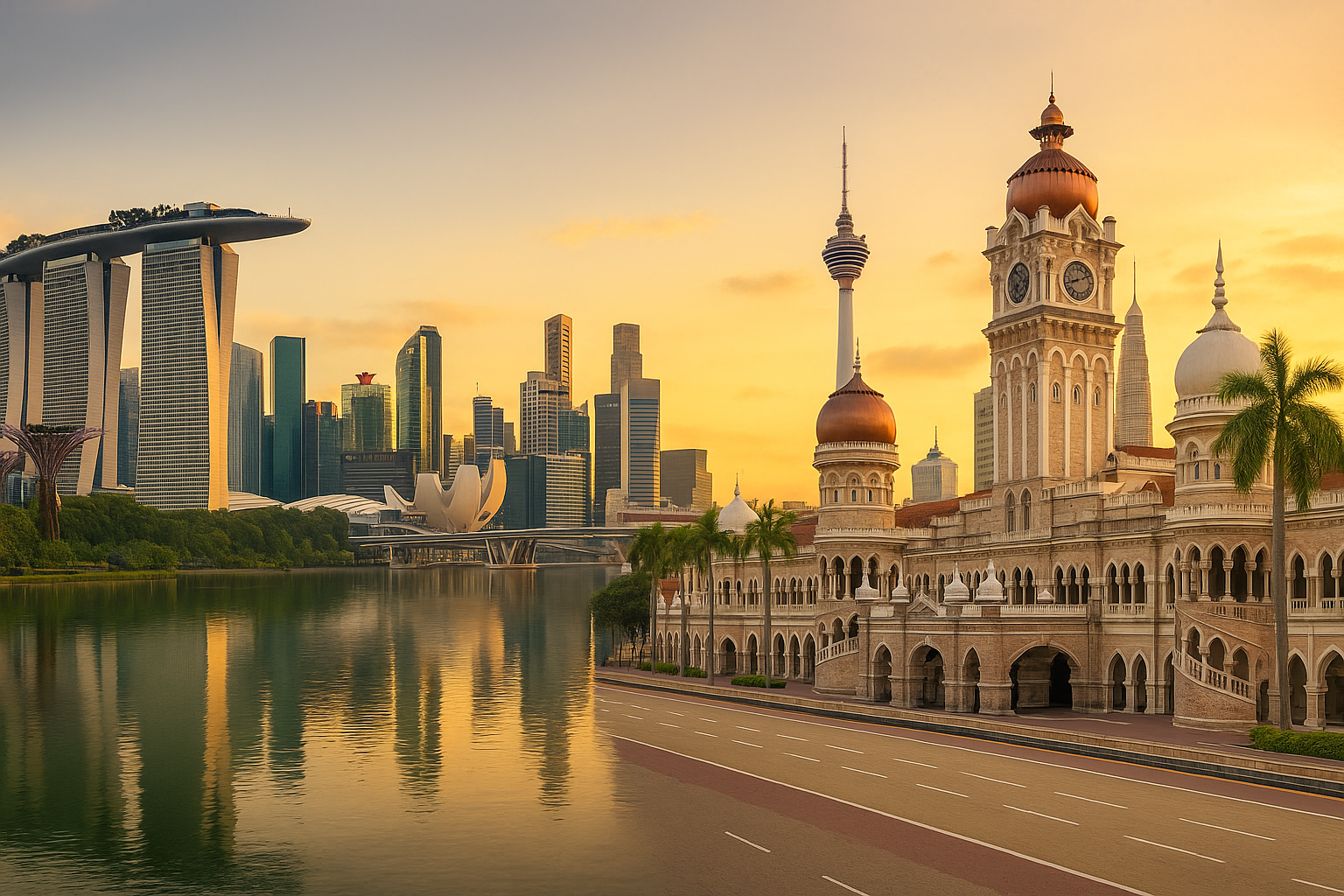
📑 Table of Contents:
- Introduction – More Than Just a Trip
- Singapore: Precision with a Beating Heart
- Malaysia: Raw, Real, and Deeply Familiar
- The Shared Pulse Between Two Nations
- Moments That Stayed With Me
- Tradition Wrapped in Tomorrow
- Crafting a Journey: Tips for Emotionally Rich Travel
- Conclusion – Two Countries, One Inner Shift
🧳 1. Introduction – More Than Just a Trip
Some places you remember. Others remember you back.
My journey through Singapore and Malaysia began not with a bucket list, but with burnout. Life had become noise—emails, meetings, performance reviews—and I didn’t need excitement. I needed stillness and clarity.
I spoke to an international travel agency in pune, hoping for a simple getaway. What I got instead was a quiet turning point. I found stillness—in unexpected corners. Clarity—in conversations with strangers. And healing—in smells that tugged at old memories. These two neighboring countries didn’t just give me places to visit. They gave me structure and soul.
🌇 2. Singapore: Precision with a Beating Heart
On the surface, Singapore is a marvel of modern engineering. But beneath the glass buildings and humming metros is a city that feels more than it shows.
I stayed near Tiong Bahru, a place where you can sip third-wave coffee inside colonial-era buildings. One morning, I stumbled upon an old bookstore. A man in his 60s was cataloging dusty paperbacks. We ended up talking about the fading scent of ink and the rise of e-books.
He said, “We’re efficient now, yes. But efficiency is hollow if we forget how to pause.”
That sentence followed me through my trip.
From the calm of Gardens by the Bay to the prayer-soaked corridors of Sri Mariamman Temple, I realized that Singapore didn’t bury its past. It nurtured it. It grew the future around it.
This city taught me that modernity doesn’t need to erase history. It can be a frame through which heritage breathes more freely.
🕌 3. Malaysia: Raw, Real, and Deeply Familiar
Malaysia was different from the moment I arrived.
There was noise. Smell. Heat. People selling nasi lemak on sidewalks and children chasing pigeons through open mosques. It was messy, but not chaotic. It felt like life in its unfiltered form.
In Penang, I met an old painter who worked on murals without ever signing them. “Art isn’t about the artist,” he told me. “It’s about whether a stranger feels something when they pass by.”
That night, walking past his work—an elderly woman serving food to children—I felt a lump in my throat. Not because the art was beautiful. But because it reminded me of my grandmother, who did the same.
Malaysia doesn’t curate your experience. It lets you walk into it as you are—and feel what you’re ready to feel.
🌏 4. The Shared Pulse Between Two Nations
Though Singapore and Malaysia feel like contrasts, they beat with the same ancestral rhythm.
Both were carved by colonial hands. Both cradled by rivers, by spice routes, by migration and trade. They grew up together, separated politically but never emotionally.
You taste it in the food: roti prata in Singapore, roti canai in Malaysia. Same roots, different spices.
You hear it in languages: Malay, Tamil, Mandarin, English—intertwined like vines, wrapping through the streets, prayers, and schools.
Their modern faces may differ—one all structure, the other all sensation—but their soul is shared.
💬 5. Moments That Stayed With Me
Some of the most powerful experiences I had weren’t tours or excursions. They were moments that weren’t meant to be remembered:
- A Singaporean uncle offering me directions and then insisting I eat with him afterward.
- A Malaysian cab driver in Ipoh who paused mid-drive to buy me jackfruit from a roadside stall, saying, “You must try this. It tastes like home.”
- A little girl in Melaka who showed me her school’s prayer room and whispered, “This is where we ask for dreams.”
These weren’t postcard scenes. But they became chapters of my heart.
🏛️ 6. Tradition Wrapped in Tomorrow
What stood out to me most was how neither country was clinging to nostalgia.
They weren’t trying to “preserve” culture like a museum exhibit. They were living it. Evolving it. Singapore’s temples sit beside tech parks. Malaysia’s Gurdwaras echo with daily langar alongside booming karaoke bars.
It made me question what “progress” truly means. It’s not about removing what’s old. It’s about making sure the next generation feels proud of it.
As a traveler, I didn’t just witness culture. I participated in a living version of it.
🧭 7. Crafting a Journey: Tips for Emotionally Rich Travel
If you’re planning this trip not just for photos but for depth, here’s what I learned:
- Slow Down. Skip the 5-attraction-a-day madness. Linger. Let places talk back.
- Stay Local. Boutique hotels, homestays, family inns—they hold the heartbeat.
- Walk Alone. You’ll hear yourself better on the streets of George Town than in any meditation app.
- Eat Where It’s Noisy. That’s where families eat. And that’s where stories live.
- Talk Less, Ask More. Locals carry stories we travelers often miss because we’re too busy explaining our own.
🎒 8. Conclusion – Two Countries, One Inner Shift
Before this trip, I didn’t know that travel could rewire how I remember.
Singapore showed me that silence can be sacred. Malaysia reminded me that noise can be nourishing. Together, they gave me what therapy hadn’t—a mirror, not for who I was, but who I could become.
This wasn’t a holiday. It was a gentle breaking open of the walls I didn’t know I had built around my own sensitivity.
And if you’re reading this, thinking, “Maybe I should go,” let this be your nudge. Go. Don’t just travel to see the world. Travel to feel your place in it again.
Even now, as I explore other places—like browsing kerala tour packages from pune for a more soul-soothing experience—I carry a part of Singapore and Malaysia with me. Because some journeys don’t end when you come home. They begin there.
Frequently Asked Questions (FAQ)
FAQ 1: Why did you choose to visit Singapore and Malaysia together?
Answer:
Honestly, I didn’t choose them for any deep reason at first. It was more of a “two-in-one” plan—close by, easy flights. But looking back, I think they found me when I needed them most. Singapore gave me quiet, space to think. Malaysia gave me warmth, people who made me feel seen. Together, they helped me slow down and feel alive again.
FAQ 2: What surprised you the most during your trip?
Answer:
How much strangers were willing to give—time, help, even food—without expecting anything. In Ipoh, a cab driver bought me jackfruit just because I looked tired. In Singapore, an aunty walked me to the bus stop when I got lost. I was ready for sightseeing. I wasn’t ready to be treated like family.
FAQ 3: Was it emotionally hard to travel solo in two countries?
Answer:
At times, yes. Especially in quiet moments—late evenings in hotel rooms or watching families walk by. But it also gave me space to listen to my own thoughts. To cry without hiding. To laugh at small things like a kid waving from a bus window. I think this kind of travel heals in ways you don’t expect.
FAQ 4: How are Singapore and Malaysia different, emotionally?
Answer:
Singapore feels like a neat journal. Everything has its place. You breathe slower, think cleaner. Malaysia is like a diary full of scribbles—raw, warm, and chaotic in a beautiful way. One made me reflect, the other made me feel. It’s like visiting two emotions you forgot you needed.
FAQ 5: Would you do it again? Would you recommend it to others?
Answer:
In a heartbeat. Not just for the places, but for what it brings out in you. I’d recommend it to anyone who’s feeling stuck. Don’t go to collect photos. Go to remember parts of yourself that have been quiet for too long.



